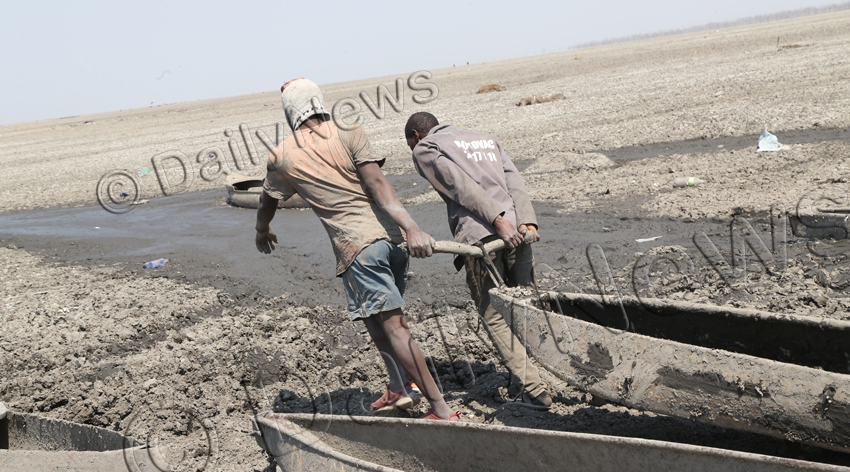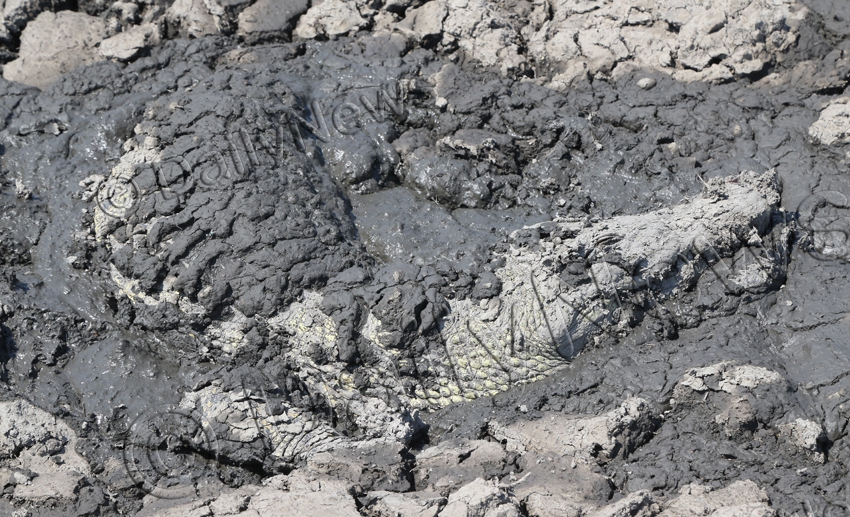Lake Ngami A race against time
20 Sep 2019
Following the dry spell that led to the drying up of Lake Ngami, things have become worse, with the last mud patch left on the Lake about to dry up completely.
The lake looks poised to swallow the last of its inhabitants, following the tragic fate of hundreds of cattle that died a slow and agonising deaths, trapped in the mud over the past few weeks.
Hippos, catfish and marabou stork birds are the last ‘men’ standing. But death is imminent. For marabou storks, lurking around scavenging for carcasses of the lake’s victims, it is a meat feast.
Like vultures, their timing is impeccable, as there is plenty of meat from one or two hippo carcasses lying around. At this rate, they are guaranteed much more, as one by one, more wildlife succumb to the now inhabitable lake.
After weeks of the dry spell, the small muddy patch left on the lake has shrunk drastically due to rapid evaporation threatening the lives of hippos, catfish and the two crocodiles spotted at an even tinier patch a few hundred metres away.
There is now an increased threat of these species losing their natural habitat in a matter of weeks or less.
For fishermen who camp around the lake, it is a race against time to salvage whatever supplies of catfish or twene are left before the patch dries up completely.
Once that happens, it will be the end of their fishing business in the lake, until and unless the lake fills up again.
“I do not even think this will last beyond September,” one of the fishermen Mr Alex Mothibi said in an interview.
In addition to the time factor, navigating through the mud to reach the fish has become more labour intensive as the mud is denser.
In addition, there is the danger of hippos, lurking a few metres away trying to survive by guarding their spot in the limited dampness left.
The lake is now a shadow of its former self. At the height of its glory, Lake Ngami was a source of a bustling fish industry, supplying countries such as Zambia and the Democratic Republic of Congo.
This impending fishery demise should not come as a surprise according to Glenn Merron, who penned an academic journal article titled Lake Ngami: A Fluctuating Lacustrine Fishery.
The author considers the lake’s fishery as a ‘boom’ resource during phases of high waters, while also labelling it a ‘bust’ resource when the lake dries up. So despite the scale of tragedy, this was sadly to be expected.
While there has been a lot of media attention on the rapidly declining Lake Ngami water levels, with some considering this the first of its kind. History begs to differ.
Indigenous knowledge from elders of the affected villages and documented literature demonstrate that from time to time, the lake dries up.
Merron states that the lake has dried up a couple of times before, dating back to the 18th century, between the years 1900 to 1910 as well as the 1930s, early 70s and early 80s.
While the degree of the tragedy may leave some feeling like it is the worst ever recorded, Kgosi Boitiro Dithapo of Sehithwa recalls far worse times.
“Way back in 1983, were faced with the same predicament we are faced with now.
The lake had dried up and there was devastation all around, with livestock dying at a worrying rate,” he states matter-of-factly.
Merron’s article also confirms 1983 as one of the years that the lake completely dried up.
“The situation was so severe that we had to request the then President, Sir Ketumile Masire to pay a visit to the lake to witness the devastation that we were confronted with first hand. I recall that the former President Mr Festus Mogae was the Permanent Secretary to the President at the time,” Kgosi Dithapo narrates.
He points out that relying on a lake or a river as a source of water for livestock and general pastoral farming is not particularly sustainable.
Boreholes, he notes, though expensive, are much more reliable compared to dealing with the uncertainty of water levels of lakes and rivers.
That notwithstanding Kgosi Dithapo’s optimism about the lake’s future remains resolute. “Modimo ga o ngalelwe, nna ke nale tshepo mo Modimong jalo seemo se ga se ntshose. Pula e ne ya na ka ngwaga wa 1983 morago ga leuba leo, jalo he, le gompieno go tla nna fela jalo ( I trust in God that the situation, just like the 1983 drought, will pass),” he said, expressing hope.
Kgosi’s version of events is also corroborated by 89-year-old Legothwane resident and long-time farmer, Mr Ditselepele Ditsilepele.
Though he does not recall the actual dates, he has lived long enough to observe that the lake dries up occasionally.
“E nna e dira jalo, e a re boloka e bo e senya gape,” he says, having lost most of his livestock to the latest tragedy. It seems no farmer has been spared.
Livestock losses, he shares are nothing new, however what is different is that this time Lake Ngami stayed flooded for longer before drying out, hence their livestock got used to it as their source of water. Like kgosi, Mr Ditsilepele feels more boreholes could help.
Based on past experiences with the lake, residents and the entire lake ecology may be in for harder times ahead as there is no telling how long the lake will remain dry.
As Glenn Merron points out in his article, the lake goes through dramatic hydrological cycles for lengthy periods of receiving flood waters and then goes through severely dry periods, based on prevailing climatic conditions in the Angolan highlands.
As such the ecology of the lake determines the habitat it attracts. But as things stand, the entire ecosystem of the lake is already feeling the heat, literally.
For the surviving wildlife species here, death is certain, life is not. ENDS
Source : BOPA
Author : Ludo Chube
Location : MAUN
Event : INTERVIEWS
Date : 20 Sep 2019







